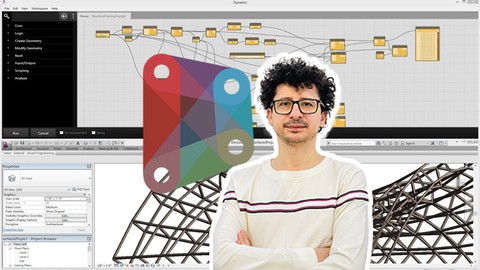
BIM- Dynamo Elementary (Level 1)- Project Based
BIM- Dynamo Elementary (Level 1)- Project Based, available at $19.99, has an average rating of 4.78, with 78 lectures, based on 110 reviews, and has 7271 subscribers.
You will learn about Introduction to Dynamo and its Interface Data Types and Data Structures in Dynamo Creating and Modifying Geometry in Dynamo Essential Nodes in Dynamo Working with Lists and Loops Using Conditional Statements and Boolean Logic Working with Text and Strings in Dynamo Importing and Exporting Data in Dynamo Collaborating and Sharing Workflows in Dynamo Creating Custom Nodes in Dynamo This course is ideal for individuals who are BIM Modelers or BIM Coordinators or BIM Managers or 3D Modelers or Architects or Engineers or Construction Managers It is particularly useful for BIM Modelers or BIM Coordinators or BIM Managers or 3D Modelers or Architects or Engineers or Construction Managers.
Enroll now: BIM- Dynamo Elementary (Level 1)- Project Based
Summary
Title: BIM- Dynamo Elementary (Level 1)- Project Based
Price: $19.99
Average Rating: 4.78
Number of Lectures: 78
Number of Published Lectures: 78
Number of Curriculum Items: 78
Number of Published Curriculum Objects: 78
Original Price: $19.99
Quality Status: approved
Status: Live
What You Will Learn
- Introduction to Dynamo and its Interface
- Data Types and Data Structures in Dynamo
- Creating and Modifying Geometry in Dynamo
- Essential Nodes in Dynamo
- Working with Lists and Loops
- Using Conditional Statements and Boolean Logic
- Working with Text and Strings in Dynamo
- Importing and Exporting Data in Dynamo
- Collaborating and Sharing Workflows in Dynamo
- Creating Custom Nodes in Dynamo
Who Should Attend
- BIM Modelers
- BIM Coordinators
- BIM Managers
- 3D Modelers
- Architects
- Engineers
- Construction Managers
Target Audiences
- BIM Modelers
- BIM Coordinators
- BIM Managers
- 3D Modelers
- Architects
- Engineers
- Construction Managers
Note: The main difference in this course compared to others is that we have not confined ourselves to explaining simple techniques. Instead, we have conveyed the subject through challenging projects and specific tricks, which are the result of numerous experiences.
-
Curious about visual programming and its impact on design?
-
Want to take your design and engineering skills to new heights?
-
Are you tired of repetitive tasks holding back your creative design process?
Dynamo stands out as an immensely potent visual programming platform, a tool that not only empowers its users to automate intricate tasks but also allows them to craft customized workflows that can significantly enhance their design capabilities. In the realm of design, engineering, and architecture.
This comprehensive course has been meticulously crafted to serve as your guide on an enlightening journey through the fundamental principles of Dynamo. Through a meticulously structured curriculum, you’ll embark on a step-by-step exploration of Dynamo’s features, gradually unraveling its intricacies.
Headlines:
-
Introduction to Dynamo and its Interface
-
Data Types and Data Structures in Dynamo
-
Creating and Modifying Geometry in Dynamo
-
Essential Nodes in Dynamo
-
Working with Lists and Loops
-
Using Conditional Statements and Boolean Logic
-
Working with Text and Strings in Dynamo
-
Importing and Exporting Data in Dynamo
-
Collaborating and Sharing Workflows in Dynamo
-
Creating Custom Nodes in Dynamo
If you are currently a BIM modeler or planning to become one, it is essential not to limit yourself to any form. You should be able to manage any architectural design in the BIM process And in the end, you will be an expert BIM Modeler. Please watch this course and feel free to ask me any questions you have while watching it.
Course Curriculum
Chapter 1: What is Dynamo
Lecture 1: Introduction
Chapter 2: Exercise File
Lecture 1: Exercise File
Chapter 3: The Difference Between Dynamo and Grasshoper
Lecture 1: The Difference Between Dynamo and Grasshoper
Chapter 4: Comparison Between Coding and Dynamo
Lecture 1: Comparison Between Coding and Dynamo
Chapter 5: The Difference Between C# and Dynamo Script
Lecture 1: The Difference Between C# and Dynamo Script
Chapter 6: Dynamo Installation and Software That Can be Installed
Lecture 1: Dynamo Installation and Software That Can be Installed
Chapter 7: Benefits of Dynamo Player
Lecture 1: Benefits of Dynamo Player
Chapter 8: Dynamo User Interface
Lecture 1: Getting to Know the User Interface in Dynamo
Lecture 2: Getting to Know the User Interface in Dynamo
Lecture 3: Work Environment or Graph
Lecture 4: Exporting 3D Background in Dynamo
Lecture 5: Editing Environment
Lecture 6: Sorting Nodes
Lecture 7: Manage Warnings in Dynamo
Chapter 9: Installation and Use Dynamo Packages
Lecture 1: Installation and Use Dynamo Packages
Chapter 10: Settings Menu Options in Dynamo
Lecture 1: Explanation of the Setting Menu
Lecture 2: Explanation of the Setting Menu
Chapter 11: Meaning and Usage of Dynamo Library
Lecture 1: Getting to Know the Library in Dynamo
Lecture 2: Mouse Performance in Dynamo Environment
Lecture 3: Basic Introduction to Scripting
Chapter 12: Nodes in Dynamo
Lecture 1: All About Nodes
Lecture 2: All About Nodes
Lecture 3: Different Types of Node Status
Lecture 4: All About the Wire
Chapter 13: Types of Inputs Nodes in Dynamo
Lecture 1: Input Nodes in Dynamo
Chapter 14: Operational Nodes
Lecture 1: Application of Operator in Dynamo
Lecture 2: Difference Between And & Or in Dynamo
Chapter 15: List Nodes in the First Part of Dynamo
Lecture 1: The Use of the List Create in the Data
Lecture 2: The Use of the List Create in the Geometry
Chapter 16: Lacing Features
Lecture 1: Application of Lacing in Nodes
Chapter 17: List Nodes in Dynamo Part Two
Lecture 1: Range in Dynamo
Lecture 2: List Contains, List All Indices of
Lecture 3: List Count
Lecture 4: Filter by Boolmask
Lecture 5: Fist & Last Items
Lecture 6: List Chop, List Shift Index
Lecture 7: List Sequence
Lecture 8: Create the First Geometry in Dynamo
Lecture 9: Create the First Geometry in Dynamo
Chapter 18: Meaning of Level in Dynamo
Lecture 1: Meaning of Level in Dynamo
Chapter 19: Points and Curves Nodes in Dynamo
Lecture 1: Points
Lecture 2: Line
Lecture 3: Arc
Lecture 4: PolyCurve
Lecture 5: NurbsCurve
Lecture 6: Changing the Location of Geometries
Chapter 20: Dynamo Introductory Examples
Lecture 1: Using Curve, Line and Point for Creating Geometry
Lecture 2: Creating Parametric Shapes by Using Numbers
Chapter 21: Surface Nodes in Dynamo
Lecture 1: Simple Example for Surface
Lecture 2: Simple Example for Surface
Chapter 22: Solid Nodes in Dynamo
Lecture 1: Convert Surface to Solid
Lecture 2: Import Solid to Revit
Lecture 3: Import Solid to Revit by Direct Shape
Lecture 4: Export to SAT
Chapter 23: Some Examples in Dynamo
Lecture 1: Simple Example of Loft
Lecture 2: Simple Example of Solid
Lecture 3: Using Formula to Create Shapes
Lecture 4: Using Formula to Create Shapes
Lecture 5: Using Math to Create Shapes
Lecture 6: Take a Part the Shape
Lecture 7: Simple Example Shape of Tower
Lecture 8: Simple Example Shape of Tower
Lecture 9: Simple Example Shape of Tower
Chapter 24: Example of Absorption Point in Dynamo
Lecture 1: Example of Absorption Point in Dynamo
Chapter 25: An Example of Image-Based Modeling in Dynamo
Lecture 1: Image-Based Modeling in Dynamo
Lecture 2: Image-Based Modeling in Dynamo
Chapter 26: An Example of Randomly Coloring Glass Wall Panels
Lecture 1: Randomly Coloring Glass Wall Panels
Chapter 27: An Example of Stair Modeling with Dynamo
Lecture 1: Stair Modeling With Dynamo
Lecture 2: Stair Modeling With Dynamo
Chapter 28: Example of Porosity in Geometry
Lecture 1: Make Holes in the Shape
Lecture 2: Make Holes in the Shape
Chapter 29: Panels in Dynamo
Instructors
-
Ghasem Ariyani • BIM Manager
BIM Manager, BIM Modeler, Revit Expert
Rating Distribution
- 1 stars: 0 votes
- 2 stars: 7 votes
- 3 stars: 14 votes
- 4 stars: 8 votes
- 5 stars: 81 votes
Frequently Asked Questions
How long do I have access to the course materials?
You can view and review the lecture materials indefinitely, like an on-demand channel.
Can I take my courses with me wherever I go?
Definitely! If you have an internet connection, courses on Udemy are available on any device at any time. If you don’t have an internet connection, some instructors also let their students download course lectures. That’s up to the instructor though, so make sure you get on their good side!
You may also like
- Best Investing Courses to Learn in March 2025
- Best Personal Finance Courses to Learn in March 2025
- Best Health And Wellness Courses to Learn in March 2025
- Best Chatgpt And Ai Tools Courses to Learn in March 2025
- Best Virtual Reality Courses to Learn in March 2025
- Best Augmented Reality Courses to Learn in March 2025
- Best Blockchain Development Courses to Learn in March 2025
- Best Unity Game Development Courses to Learn in March 2025
- Best Artificial Intelligence Courses to Learn in March 2025
- Best Flutter Development Courses to Learn in March 2025
- Best Docker Kubernetes Courses to Learn in March 2025
- Best Business Analytics Courses to Learn in March 2025
- Best Excel Vba Courses to Learn in March 2025
- Best Devops Courses to Learn in March 2025
- Best Angular Courses to Learn in March 2025
- Best Node Js Development Courses to Learn in March 2025
- Best React Js Courses to Learn in March 2025
- Best Cyber Security Courses to Learn in March 2025
- Best Machine Learning Courses to Learn in March 2025
- Best Ethical Hacking Courses to Learn in March 2025






















